Engine compartment

1. Power steering fluid reservoir.
2. Engine oil filler cap.
3. Engine oil level dipstick.
4. Brake fluid reservoir.
5. Battery.
6. Fuse box.
7. Electric cooling fans.
8. Condenser.
9. Radiator.
10. Washer fluid tank.
11. Engine coolant reservoir.
Engine compartment cover
Removing the engine compartment cover
 Front
Front

 Right-hand side
Right-hand side

When installing the cover, make sure that the engine coolant reservoir hose positioned as shown in the illustration.
 Left-hand side
Left-hand side

Installing the clips

1. Press the tip of the clip against a hard surface, such as a desk, to allow the center part of the clip to be pushed up.
2. Insert.
3. Press.
Engine oil
With the engine at operating temperature and turned off, check the oil level on the dipstick.
Checking the engine oil
1. Park the vehicle on level ground. After turning off the engine, wait more than five minutes for the oil to drain back into the bottom of the engine.

2. Hold a rag under the end and pull the dipstick out.
3. Wipe the dipstick clean.
4. Reinsert the dipstick fully.
5. Holding a rag under the end, pull the dipstick out and check the oil level.
6. Wipe the dipstick and reinsert it fully.

1. Low.
2. Full.
Adding engine oil

If the oil level is below or near the low level mark, add engine oil of the same type as already in the engine.
Make sure to check the oil type and prepare the items needed before adding oil.

1. Remove the oil filler cap.
2. Add engine oil slowly, checking the dipstick.
3. Install the filler cap, turning it clockwise.
Engine oil consumption
The amount of engine oil consumed depends on the oil viscosity, the quality
of
the oil and the way the vehicle is driven.
- More oil is consumed under driving conditions such as high speeds and frequent acceleration and deceleration.
- A new engine consumes more oil.
- When judging the amount of oil consumption, keep in mind that the oil may have become diluted, making it difficult to judge the true level accurately.
- Oil consumption: Max. 1.1 qt./600 miles, 0.9 lmp.qt./600 miles (1.0 L per 1000
km)
- If you consume more than 1.1 qt. (1.0 L, 0.9 lmp.qt.) every 600 miles (1000
km),
contact your Lexus dealer.
Changing the engine oil (USA only)
To reset the oil change system, follow the procedure below: 1. Turn the “ENGINE START STOP” switch OFF with the trip meter A reading shown.
2. While pressing the trip meter reset button, set the “ENGINE START STOP” switch to the IGNITION ON mode. Continue to press and hold the button until the trip meter displays “000000”.
CAUTION:
Used engine oil
- Used engine oil contains potentially harmful contaminants which may cause skin
disorders such as inflammation or skin cancer, so care should be taken to avoid
prolonged and repeated contact. To remove used engine oil from your skin, wash
thoroughly with soap and water.
- Dispose of used oil and filters only in a safe and acceptable manner. Do not
dispose
of used oil and filters in household trash, in sewers or onto the ground.
Call your Lexus dealer, service station or auto parts store for information
concerning
recycling or disposal.
- Do not leave used engine oil within the reach of children.
NOTICE:
To prevent serious engine damage
Check the oil level on regular basis.
When replacing the engine oil - Be careful not to spill engine oil on the vehicle components.
- Avoid overfilling, or the engine could be damaged.
- Check the oil level on the dipstick every time you refill the vehicle.
- Be sure the engine oil filler cap is properly retightened.
Engine coolant
The coolant level is satisfactory if it is between the F and L lines on the
reservoir
when the engine is cold.
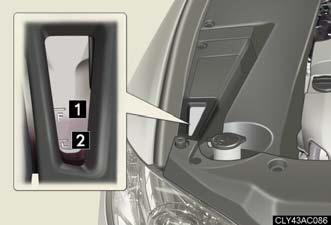
1. Full.
2. Low.
If the level is on or below the L line, add coolant up to the F line.
When adding the engine coolant
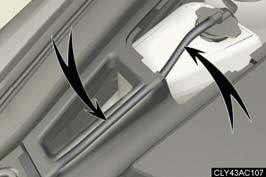
When installing the reservoir cap, make sure that the engine coolant reservoir hose positioned as shown in the illustration.
If the coolant level drops within a short time after replenishing
Visually check the radiator, hoses, engine coolant filler cap, radiator cap,
drain cock
and water pump.
If you cannot find a leak, have your Lexus dealer pressure test the cap and
check for
leaks in the cooling system.
Coolant selection
Only use “Toyota Super Long Life Coolant” or similar high quality ethylene
glycol
based non-silicate, non-amine, non-nitrite, and non-borate coolant with
long-life
hybrid organic acid technology.
USA: “Toyota Super Long Life Coolant” is a mixture of 50% coolant and 50% deionized water. (Enabled: -31°F [-35°C]).
Canada: “Toyota Super Long Life Coolant” is a mixture of 55% coolant and 45% deionized water. (Enabled: -44°F [-42°C]).
For more details about engine coolant, contact your Lexus dealer.
CAUTION:
When the engine is hot
Do not remove the radiator cap.
The cooling system may be under pressure and may spray hot coolant if the cap is removed, causing burns or other injuries.
NOTICE:
When adding engine coolant
Coolant is neither plain water not straight antifreeze. The correct mixture of
water
and anti freeze must be used to provide proper lubrication, corrosion protection
and cooling. Be sure to read the antifreeze or coolant label.
If you spill coolant
Be sure to wash it off with water to prevent damage to parts or paint.
Radiator and condenser
Check the radiator and condenser and clear any foreign objects.
If either of the above parts are extremely dirty or you are not sure of their condition, have your vehicle checked by your Lexus dealer.
CAUTION:
When the engine is hot
Do not touch the radiator or condenser, as they may be hot and you may be
burned.
Brake fluid
Checking fluid level
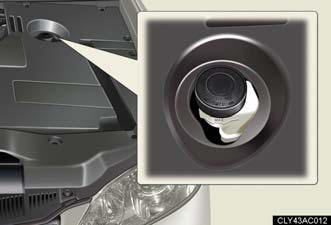
The brake fluid level should be between the “MAX” and “MIN” lines on the tank.
Make sure to check the fluid type and prepare the necessary items.
Adding fluid

Brake fluid can absorb moisture from the air
Excess moisture in the fluid can cause a dangerous loss of braking
efficiency. Use
only newly opened brake fluid.
CAUTION:
When filling the reservoir
Take care because brake fluid can harm your hands or eyes and damage painted
surfaces.
If fluid gets in your eyes, flush your eyes with clean water immediately.
If you still experience discomfort, see a doctor.
NOTICE:
If the fluid level is low or high
It is normal for the brake fluid level to go down slightly as the brake pads
wear or
when the fluid level in the accumulator is high.
If the reservoir needs frequent refilling, it may indicate a serious problem.
Power steering fluid
Fluid level
The fluid level should be within the appropriate range.
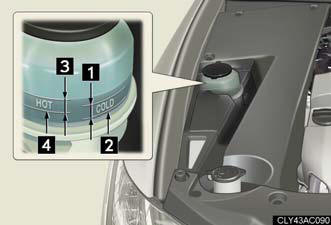
1. Full (when cold).
2. Add fluid (when cold).
3. Full (when hot).
4. Add fluid (when hot).
Hot: Vehicle has been driven around 50 mph (80 km/h) for 20 minutes, or slightly longer in frigid temperatures. (Fluid temperature, 140°F - 175°F [60°C - 80°C]).
Cold: Engine has not been run for about 5 hours. (Room temperature, 50°F - 85°F [10°C - 30°C]).
Checking the fluid level
Make sure to check the fluid type and prepare the necessary items.

1. Clean all dirt off the reservoir.
2. Remove the reservoir cap by turning it counterclockwise and wipe the dipstick clean.
3. Reinstall the reservoir cap.
4. Remove the reservoir cap again and look at the fluid level.
CAUTION:
Checking the fluid level
Take care, as the reservoir may be hot.
NOTICE:
When adding fluid
Avoid overfilling, or the power steering may be damaged.
After replacing the reservoir cap Check the steering box case, vane pump and hose connections for leaks or damage.
Battery
Check the battery as follows.
Battery exterior
Make sure that the battery terminals are not corroded and that there are no loose connections, cracks, or loose clamps.
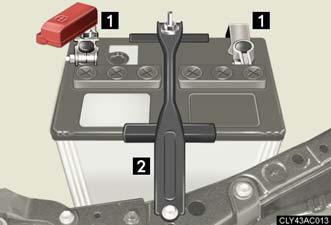
1. Terminals.
2. Hold-down clamp.
Checking battery condition (vehicles with the battery indicator)
Check the battery condition using the indicator color.
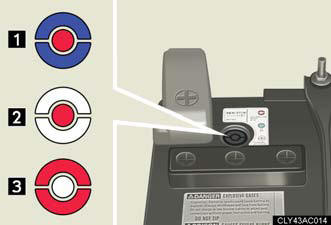
1. Blue: Good condition.
2. White: Charging is necessary.
Have the vehicle inspected by your Lexus dealer.
3. Red: Not working properly, have the battery checked by your Lexus dealer.
Before recharging
When recharging, the battery produces hydrogen gas which is flammable and
explosive. Therefore, before recharging:
- If recharging with the battery installed on the vehicle, be sure to disconnect
the
ground cable.
- Make sure the power switch on the charger is off when connecting and
disconnecting
the charger cables to the battery.
After recharging the battery
The engine may not start. Follow the procedure below to initialize the system.
1. Shift the shift lever to P.
2. Open and close any of the doors.
3. Restart the engine.
CAUTION:
Chemicals in the battery
A battery contains poisonous and corrosive sulfuric acid and may produce
hydrogen
gas which is flammable and explosive. To reduce the risk of death or serious
injury, take the following precautions while working on or near battery:
- Do not cause sparks by touching the battery terminals with tools.
- Do not smoke or light a match near the battery.
- Avoid contact with eyes, skin and clothes.
- Never inhale or swallow electrolyte.
- Wear protective safety glasses when working near the battery.
- Keep children away from the battery.
Where to safety charge the battery
Always charge the battery in an open area. Do not charge the battery in a garage
or
closed room where there is not sufficient ventilation.
How to recharge the battery
Only perform a slow charge (5 A or less). The battery may explode if charged at
a
quicker rate.
Emergency measures regarding electrolyte
- If electrolyte gets in your eyes
Flush your eyes with clean water for at least 15 minutes and get immediate
medical
attention. If possible, continue to apply water with a sponge or cloth while
traveling to the nearest medical facility.
- If electrolyte gets on your skin
Wash the affected area thoroughly. If you feel pain or burning, get medical
attention
immediately.
- If electrolyte gets on your clothes
It can soak through clothing on to your skin. Immediately take off the clothing
and
follow the procedure above if necessary.
- If you accidentally swallow electrolyte
Drink a large quantity of water or milk. Follow with milk of magnesia, beaten
raw
egg or vegetable oil. Get emergency medical attention immediately.
NOTICE:
When recharging the battery
Never recharge the battery while the engine is running. Also, be sure all
accessories
are turned off.
Washer fluid
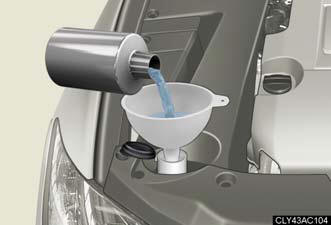
If any washer does not work or the warning message appears on the multi-information display, the washer tank may be empty. Add washer fluid.
CAUTION:
When refilling the washer fluid
Do not refill the washer fluid when the engine is hot or running, as the washer
fluid
contains alcohol and may catch fire if spilled on the engine etc.
NOTICE:
Do not use any fluid other than washer fluid
Do not use soapy water or engine antifreeze instead of washer fluid.
Doing so may cause streaking on the vehicle’s painted surfaces.
Diluting washer fluid
Dilute washer fluid with water as necessary.
Refer to the freezing temperatures listed on the washer fluid tank.
See also:
Under the Hood
For 2006, the 4.7-liter V-8 produces 263 hp and 323 pounds-feet of torque.
Those numbers are down slightly from the 2005 model's 270 hp and 330 pounds-feet
of torque due to new SAE testing procedu ...
Luxury/Comfort/Convenience
The standard Regency leather-trimmed, heated, 10-way power front seats
(perforated leather trim on Lexus GS 460) are comfortably contoured for support
on long trips. Ventilated front seats are sta ...
Tire information
Typical tire symbols
Standard tire
Compact spare tire
1. Tire size.
2. DOT and Tire Identification Number (TIN).
3. Location of treadwear indicators.
4. Tire ply composition and materials.
...
